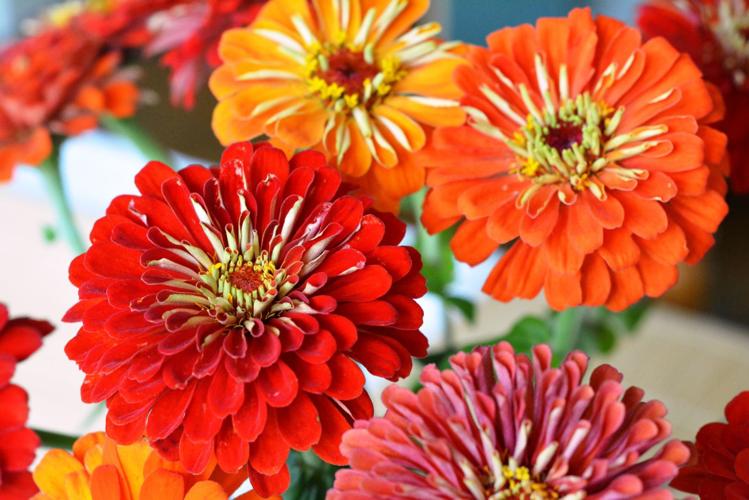Garden columnist Dan Gill answers readers' questions each week. To send a question, email Gill at gnogardening@agcenter.lsu.edu.
I’m having problems with lots of small spots on the leaves of my zinnias. Same thing happened to my zinnia last summer. I tried planting the plants farther apart for better air circulation, but these spots are still taking over my zinnias. What do I spray with? I just pulled all affected lower leaves on plants. Also, how do I control gripeweed? Thanks. — Peggy
Fungal and bacterial leaf spots are common on large flowering zinnias (Zinnia elegans). The diseases are worst when the foliage is regularly wet — either from frequent rains or irrigation. When irrigating the zinnias, try to direct the water at the base of the plant/soil and avoid wetting the foliage.
Soaker hoses are a good way to water flowerbeds without wetting the foliage. Spray the zinnias every seven to 10 days with a copper-based fungicide (Liquid Copper, Copper Fungicide and other brands) to help minimize leaf spots over the summer.
While hand-weeding gripeweed works well if you keep up with it, you can also kill this weed with a systemic insecticide like glyphosate (Killzall, Roundup, Eraser) or a contact herbicide like Captain Jack’s Deadweed Brew (a good organic option). Just spray these herbicides on the gripeweed.
They will damage or kill anything they are applied to. Where you cannot spray the herbicide without getting it on desirable plants, you will need to hand weed. Be sure to keep the beds well-mulched (2 inches deep) to help in your efforts to control this weed.
I have a quick question about planting centipede seeds. I have bare spots due to dry soil conditions. I plan to add a sprinkler system to correct that. My question is, given the intense heat of summer, is it too hot to plant seeds now to fill in the bare spots? — Jim Edgerton
When you think about it, centipede grass grows the fastest and needs to be mowed most often during the heat of summer, from May to October. Our lawn grasses, such as centipede, St. Augustine, bermuda and zoysia, like the heat of summer. So, the proper time to plant the centipede seeds is during the hot growing season when the seeds will germinate and grow the best. Plant seeds anytime from late April to June/early July (don't plant too late or the young plants will not be ready for winter).
Do be aware that the seedlings grow very slowly. You will not likely see good coverage until at least the end of this summer, or even sometime next year. During this time, you will need to keep the young plants properly watered during the summer. These areas will likely need more water than the rest of your lawn. And you will need to hand-pull any weeds that come up in the area (weed seeds will grow much faster than centipede seeds).
I would encourage you to consider sodding these areas. You will need to keep the newly laid sod well-watered for two or three weeks, but then you can water it like you do the rest of the lawn. In addition, you will not have as many weed issues with sodding. Finally, instead of looking at bare areas very slowly filling in by late summer or next year, as soon as you lay the sod you will have a perfectly good-looking lawn immediately. There are many advantages to sodding rather than seeding.
Some of my daylilies and agapanthus have finished flowering and they have produced seed pods. Do I cut back the stalks or just leave them alone? — Cheryl
For both of these plants, follow the stem that held the flowers back down to the foliage and cut the stem there. This prevents the wasted effort of seed formation and allows the plants to put those resources into leaves, stems and roots.

Check out the Orchard Society show this weekend at Lakeside Shopping Center.
Garden tips
ORCHID SHOW: This weekend, there will be a great opportunity to see displays of beautiful orchids and purchase orchid plants as the New Orleans Orchid Society holds its annual show and sale at Lakeside Shopping Center in Metairie. The show and sale will take place on Friday and Saturday from 10 a.m. to 9 p.m. and Sunday from noon to 4:30 p.m. The exhibit area will be closed for judging on Saturday until about noon, but sales will remain open. Vendors from Louisiana, Texas, Florida and Ecuador will sell plants and orchid-growing supplies, and members of the society will be happy to answer your questions on growing orchids.
VEGGIES NOW: Vegetables to plant in June include amaranth, cantaloupe, cucumbers, cucuzza (traditional Italian edible gourd, needs trellis), edamame (edible soybean), eggplant (choose the long, narrow Japanese types that produce better in the heat), luffa (edible gourd, also produces "sponge," needs a trellis), okra, peanuts, hot peppers, sweet peppers (not bell peppers), pumpkin, Southern peas (black-eyed, crowder, purple hull and others), Malabar spinach, squash (summer and winter), sweet potato (plant rooted cuttings called slips), watermelons, yardlong beans (needs a trellis) and heat tolerant tomatoes.
HERBS NOW: Plant herbs like basil, Mexican tarragon, lemon balm, lemon grass, perilla, sesame seeds, garlic chives and Mexican oregano.
SUMMER PESTS: Although heat-tolerant tomatoes, squash and cucumbers can be planted in June, production is difficult during mid- to late summer due to pest problems. Disease and insect problems with vegetables in general will continue to increase as we move into summer. Control them as needed.



